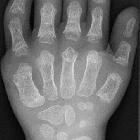post axial polydactyly
Post-axial polydactyly refers to polydactyly where the additional digit is on the ulnar margin of the hand, or lateral to the 5(little) toe.
Epidemiology
Post-axial polydactyly is more common than preaxial polydactyly, with an estimated incidence of 1 in 3000 .
Associations
Post-axial polydactyly can be associated with:
- trisomy 13
- Bardet-Biedl syndrome
- Meckel Gruber syndrome
- McKusick-Kaufman syndrome
- following oral-facial-digital syndromes (OFDS)
- oral-facial-digital syndrome (OFDS) type II - Mohr syndrome
- oral-facial-digital syndrome (OFDS) type VI
- certain skeletal dysplasias
- Smith Lemli Opitz syndrome
- certain short rib polydactyly syndromes: e.g types I and III
Pathology
The majority of cases are idiopathic. Associations with mutations to the GLI3 gene on chromosome 7 as well as a second locus mapped to chromosome 13 have been implicated in post-axial polydactyly .
Classification
Post-axial polydactyly has been defined by Temtamy and McKusick as:
- type A: additional digit at the MCP joint (or more proximally at the CMC joint)
- type B: small nubbin of non-functioning tissue or additional soft tissue on a pedicle
Or, you can use a separate three-part classification system:
- type I: nubbin or floating digit
- type II: duplications at the MCPJ
- type III: duplication of the entire ray
Siehe auch:
- Pätau-Syndrom
- Polydaktylie
- Meckel-Syndrom
- Ellis-van-Creveld-Syndrom
- asphyxierende Thoraxdysplasie (Jeune-Syndrom)
- Skelettdysplasie
- Bardet-Biedl syndrome
- Smith-Lemli-Opitz-Syndrom
- Kurzripp-Polydaktylie-Syndrome
- McKusick-Kaufman-Syndrom
- Dreigliedriger Daumen-Polysyndaktylie-Syndrom
- präaxiale Polydaktylie
- oral-facial-digital syndromes (OFDS)
- chondroectodermal dyplasia

 Assoziationen und Differentialdiagnosen zu postaxiale Polydaktylie:
Assoziationen und Differentialdiagnosen zu postaxiale Polydaktylie:






